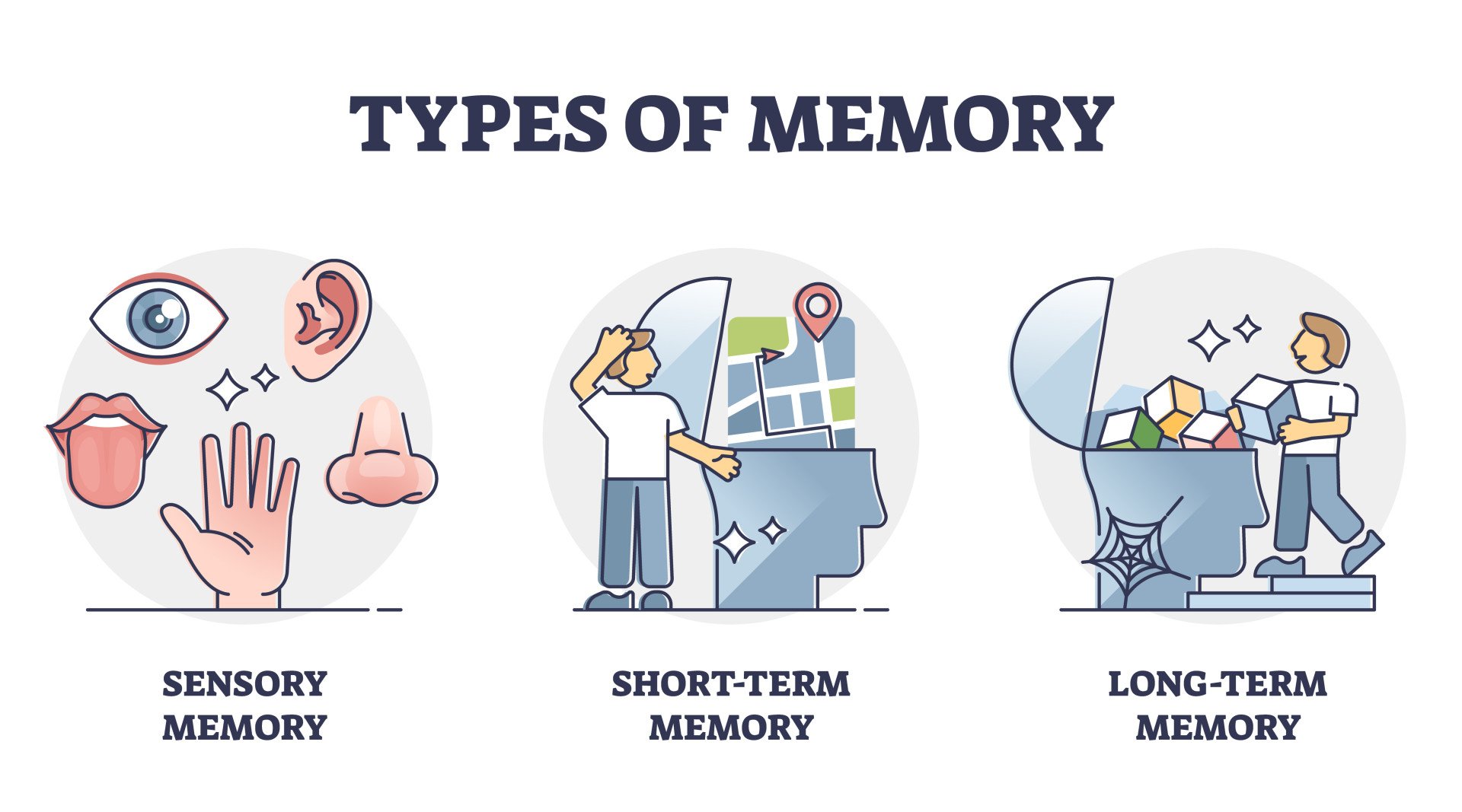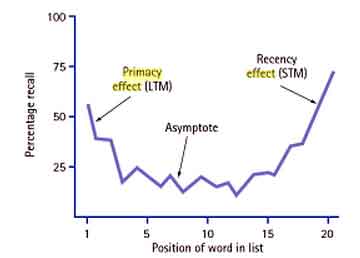What is the Multi-Store Model?
- The multi-store model is an explanation of memory proposed by Atkinson and Shiffrin which assumes there are three unitary (separate) memory stores, and that information is transferred between these stores in a linear sequence.
- The three main stores are the sensory memory, short-term memory (STM) and long-term memory (LTM).
- Each of the memory stores differs in the way information is processed (encoding), how much information can be stored (capacity), and for how long (duration).
- Information passes from store to store in a linear way, and has been described as an information processing model (like a computer) with an input, process and output.
- Information is detected by the sense organs and enters the sensory memory, which stores a fleeting impression of sensory stimuli. If attended to this information enters the STM and if the information is given meaning (elaborative rehearsal) it is passed on to the LTM
The multi-store model of memory (also known as the modal model) was proposed by Richard Atkinson and Richard Shiffrin (1968) and is a structural model. They proposed that memory consisted of three stores: a sensory register, short-term memory (STM) and long-term memory (LTM).
The Memory Stores
Each store is a unitary structure and has its own characteristics in terms of encoding, capacity and duration.
Encoding is the way information is changed so that it can be stored in the memory. There are three main ways in which information can be encoded (changed):
1. visual (picture),
2. acoustic (sound),
3. semantic (meaning).
Capacity concerns how much information can be stored.
Duration refers to the period of time information can last in the memory stores.

Sensory Memory
• Capacity: all sensory experience (v. larger capacity)
• Encoding: sense specific (e.g. different stores for each sense)
The sensory stores are constantly receiving information but most of this receives no attention and remains in the sensory register for a very brief period.
In the sensory memory store, information arrives from the 5 senses such as sight (visual information), sounds and touch. The sensory memory store has a large capacity but a very brief duration, it can encode information from any of the senses and most of the information is lost through decay.
Attention is the first step in remembering something, if a person’s attention is focused on one of the sensory stores then the data is transferred to STM.
Short Term Memory
• Duration: 0-18 seconds
• Capacity: 7 +/- 2 items
• Encoding: mainly auditory
The short-term memory store has a duration of up to 30 seconds, has a capacity of 7+/-2 chunks and mainly encodes information acoustically. Information is lost through displacement or decay.
Maintenance rehearsal is the process of verbally or mentally repeating information, which allows the duration of short-term memory to be extended beyond 30 seconds. An example of maintenance rehearsal would be remembering a phone number only long enough to make the phone call.
This type of rehearsal usually involves repeating information without thinking about its meaning or connecting it to other information.
Continual rehearsal “regenerates” or “renews” the information in the memory trace, thus making it a stronger memory when transferred to the Long Term store.
If maintenance rehearsal (repetition) does not occur, then information is forgotten, and lost from short term memory through the processes of displacement or decay.
Long Term Memory
• Duration: Unlimited
• Capacity: Unlimited
• Encoding: Mainly Semantic (but can be visual and auditory)
Long-term memory store has unlimited capacity and duration and encodes information semantically. Information can be recalled from LTM back into the STM when it is needed.
If the information is given meaning (elaborative rehearsal) it is passed on to the LTM.
Elaborative rehearsal involves the process of linking new information in a meaningful way with information already stored in long-term memory. For example,
you could learn the lines in a play by relating the dialogue and behavior of your character to similar personal experiences you remember.
Elaborative rehearsal is more effective than maintenance rehearsal for remembering new information as it helps to ensure that information is encoded well. It is a deeper level of information-processing.
Key Studies

Glanzer and Cunitz showed that when participants are presented with a list of words, they tend to remember the first few and last few words and are more likely to forget those in the middle of the list, i.e. the serial position effect.
This supports the existence of separate LTM and STM stores because they observed a primacy and recency effect.
Words early on in the list were put into long term memory (primacy effect) because the person has time to rehearse the word, and words from the end went into short term memory (recency effect).
Other compelling evidence to support this distinction between STM and LTM is the case of KF (Shallice & Warrington, 1977) who had been in a motorcycle crash where he had sustained brain damage.
His LTM seemed to be unaffected but he was only able to recall the last bit of information he had heard in his STM.
Critical Evaluation
Strengths
One strength of the multistore model is that is gives us a good understanding of the structure and process of the STM. This is good because this allows researchers to expand on this model.
This means researchers can do experiments to improve on this model and make it more valid and they can prove what the stores actually do. Therefore, the model is influential as it has generated a lot of research into memory.
Many memory studies provide evidence to support the distinction between STM and LTM (in terms of encoding, duration and capacity). The model can account for primacy & recency effects.
The case of HM also supports the MSM as he was unable to encode new long-term memories after surgery during which his hippocampus was removed but his STM was unaffected.
He has remembered little of personal (death of mother and father) or public events (Watergate, Vietnam War) that have occurred over the last 45 years. However his short-term memory remains intact.This supports the view that the LTM and the STM are two separate stores.
Weaknesses
The model is oversimplified, in particular when it suggests that both short-term and long-term memory each operate in a single, uniform fashion. We now know is this not the case.
It has now become apparent that both short-term and long-term memory are more complicated that previously thought. For example, the Working Model of Memory proposed by Baddeley and Hitch (1974) showed that short term memory is more than just one simple unitary store and comprises different components (e.g. central executive, Visuospatial etc.).
In the case of long-term memory, it is unlikely that different kinds of knowledge, such as remembering how to play a computer game, the rules of subtraction and remembering what we did yesterday are all stored within a single, long-term memory store.
Indeed different types of long-term memory have been identified, namely episodic (memories of events), procedural (knowledge of how to do things) and semantic (general knowledge).
Rehearsal is considered a too simple explanation to account for the transfer of information from STM to LTM. For instance, the model ignores factors such as motivation, effect and strategy (e.g. mnemonics) which underpin learning.
Also, rehearsal is not essential to transfer information into LTM. For example, why are we able to recall information which we did not rehearse (e.g. swimming) yet unable to recall information which we have rehearsed (e.g. reading your notes while revising).
Therefore, the role of rehearsal as a means of transferring from STM to LTM is much less important than Atkinson and Shiffrin (1968) claimed in their model.
The models main emphasis was on structure and tends to neglect the process elements of memory (e.g. it only focuses on attention and maintenance rehearsal). For example, elaboration rehearsal leads to recall of information than just maintenance rehearsal.
Elaboration rehearsal involves a more meaningful analysis (e.g. images, thinking, associations etc.) of information and leads to better recall. For example, giving words a meaning or linking them with previous knowledge. These limitations are dealt with by the levels of processing model (Craik, & Lockhart, 1972).
Note: although rehearsal was initially described by Atkinson and Shiffrin as maintenance rehearsal (repetition of information), Shiffrin later suggested that rehearsal could be elaborative (Raaijmakers, & Shiffrin, 2003).
The multi store model has been criticized for being a passive/one way/linear model.
References
Atkinson, R. C., & Shiffrin, R. M. (1968). Chapter: Human memory: A proposed system and its control processes. In Spence, K. W., & Spence, J. T. The psychology of learning and motivation (Volume 2). New York: Academic Press. pp. 89–195.
Baddeley, A .D., & Hitch, G. (1974). Working memory. In G.H. Bower (Ed.), The psychology of learning and motivation: Advances in research and theory (Vol. 8, pp. 47–89). New York: Academic Press.
Craik, F. I. M., & Lockhart, R. S. (1972). Levels of processing: A framework for memory research. Journal of Verbal Learning and Verbal behavior, 11, 671-684.
Raaijmakers, J.G.W. & Shiffrin, R.M. (2003). Models versus descriptions: Real differences and langiage differences. behavioral and Brain Sciences, 26, 753.
Shallice, T., & Warrington, E. K. (1977). Auditory-verbal short-term memory impairment and conduction aphasia. Brain and Language, 4(4), 479-491.


